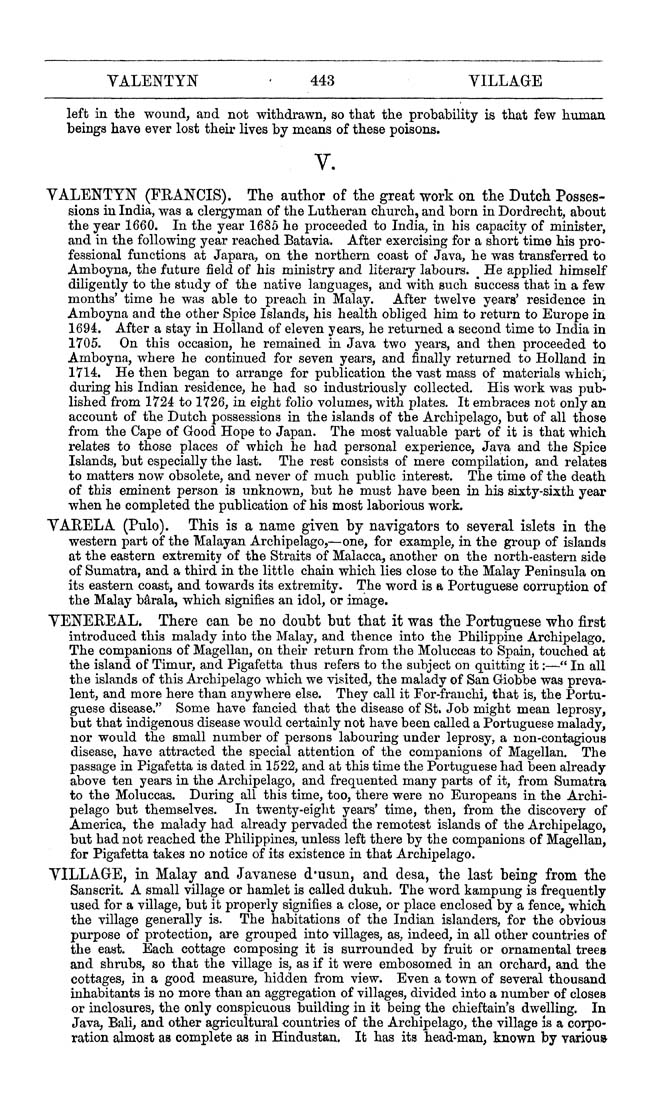YALENTYN • 443 VILLAGE
left in the wound, and not withdrawn, so that the probability is that few human
beings have ever lost their lives by means of these poisons.
V.
YALENTYN (FRANCIS). The author of the great work on the Dutch Posses¬
sions in India, was a clergyman of the Lutheran church, and born in Dordrecht, about
the year 1660. In the year 1685 he proceeded to India, in his capacity of minister,
and in the following year reached Batavia. After exercising for a short time his pro¬
fessional functions at Japara, on the northern coast of Java, he was transferred to
Amboyna, the future field of his ministry and literary labours. ^ He applied himself
diligently to the study of the native languages, and with such success that in a few
months' time he was able to preach in Malay. After twelve years' residence in
Amboyna and the other Spice Islands, his health obliged him to return to Europe in
1694. After a stay in Holland of eleven years, he returned a second time to India in
1705. On this occasion, he remained in Java two j^ears, and then proceeded to
Amboyna, where he continued for seven years, and finally returned to Holland in
1714. He then began to arrange for publication the vast mass of materials which,
during his Indian residence, he had so industriously collected. His work was pub¬
lished from 1724 to 1726, in eight folio volumes, with plates. It embraces not only an
account of the Dutch possessions in the islands of the Archipelago, but of all those
from the Cape of Good Hope to Japan. The most valuable part of it is that which
relates to those places of which he had personal experience, Java and the Spice
Islands, but especially the last. The rest consists of mere compilation, and relates
to matters now obsolete, and never of much public interest. The time of the death
of this eminent person is unknown, but he must have been in his sixty-sixth year
when he completed the publication of his most laborious work.
YARELA (Pulo). This is a name given by navigators to several islets in the
western part of the Malayan Archipelago,—one, for example, in the group of islands
at the eastern extremity of the Straits of Malacca, another on the north-eastern side
of Sumatra, and a third in the little chain which lies close to the Malay Peninsula on
its eastern coast, and towards its extremity. The word is a Portuguese corruption of
the Malay bdrala, which signifies an idol, or image.
VENEREAL. There can be no doubt but that it was the Portuguese who first
introduced this malady into the Malay, and thence into the Philippine Archipelago.
The companions of Magellan, on their return from the Moluccas to Spain, touched at
the island of Timur, and Pigafetta thus refers to the subject on quitting it:—" In all
the islands of this Archipelago which we visited, the malady of San Giobbe was preva¬
lent, and more here than anywhere else. They call it For-franchi, that is, the Portu¬
guese disease." Some have fancied that the disease of St. Job might mean leprosy,
but that indigenous disease would certainly not have been called a Portuguese malady,
nor would the small number of persons labouring under leprosy, a non-contagious
disease, have attracted the special attention of the companions of Magellan. The
passage in Pigafetta is dated in 1522, and at this time the Portuguese had been already
above ten years in the Archipelago, and frequented many parts of it, from Sumatra
to the Moluccas. During all this time, too, there were no Europeans in the Archi¬
pelago but themselves. In twenty-eight years' time, then, from the discovery of
America, the malady had already pervaded the remotest islands of the Archipelago,
but had not reached the Philippines, unless left there by the companions of Magellan,
for Pigafetta takes no notice of its existence in that Archipelago.
VILLAGE, in Malay and Javanese d'usun, and desa, the last being from the
Sanscrit. A small village or hamlet is called dukuh. The word kampung is frequently
used for a village, but it properly signifies a close, or place enclosed by a fence, which
the village generally is. The habitations of the Indian islanders, for the obvious
purpose of protection, are grouped into villages, as, indeed, in all other countries of
the east. Each cottage composing it is surrounded by fruit or ornamental trees
and shrubs, so that the village is, as if it were embosomed in an orchard, and the
cottages, in a good measure, hidden from view. Even a town of several thousand
inhabitants is no more than an aggregation of villages, divided into a number of closes
or inclosures, the only conspicuous building in it being the chieftain's dwelling. In
Java, Bali, and other agricultural countries of the Archipelago, the village is a corpo¬
ration almost as complete as in Hindustan. It has its head-man, known by various
|








